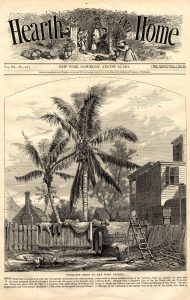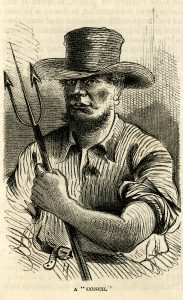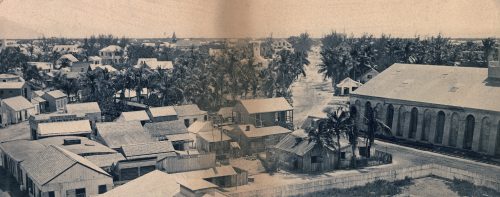Island Chronicles, vol. 19 – A Description of Key West on Christmas Eve, 1873

An engraving of the backyard of a Key West Home on the front page of Hearth and Home newspaper, August 19, 1871. Monroe County Public Library/Florida Keys History Center Collection.
Welcome to “Island Chronicles,” the Florida Keys History Center’s monthly feature dedicated to investigating and sharing events from the history of Monroe County, Florida. These pieces draw from a variety of sources, but our primary well is the FKHC’s archive of documents, photographs, diaries, newspapers, maps, and other historical materials.
By Corey Malcom, PhD
Lead Historian, Florida Keys History Center
On December 24, 1873, a reporter for the New York Times filed a dispatch from Key West, describing the town and some of its holiday celebrations. The reporter was almost certainly in Key West because the U.S. Navy was beginning to assemble a fleet at the island to conduct exercises as a show of force against Spain. Tensions between the two countries had erupted because two months earlier the Spanish had captured the American Steamship Virginius, which had been aiding Cuban insurrectionists in their Ten Years War against Spanish rule; many of the Virginius’ American crew were charged with piracy and executed.[1] In December 1873, while diplomats worked to find an acceptable resolution to the disruption created by the “Virginius Affair,” a Navy fleet was ordered to rendezvous at Key West. There, the vessels and troops were to conduct military exercises and be at the ready to attack Cuba, if necessary. Newspaper reporters from across the country were sent to the island city to cover the activities.
Since any military action was yet to happen, our reporter apparently sent a description of Key West, a place that was decidedly unusual to him, to help “set the scene” for following stories. The account is a brief but rich description of the island, and it features details of the population, social structures, houses, food, and infrastructure that were otherwise rarely told. And, of course, given the date, the reporter describes how the town celebrated Christmas – “serenading,” or caroling, apparently being a popular way to celebrate the holiday. Unfortunately, tensions between groups of Key Westers and Navy personnel (likely fueled by too much alcohol) turned the holiday’s good cheer into a brawl.
The following transcript is true to the original account, with the writer’s spelling and punctuation maintained. The only change is that the text has been broken into paragraphs to help delineate the themes of the description. Footnotes have been added to clarify the text or add details where needed. All in all, this succinct, nicely written report is a bit of a gem, and it helps bring to life Christmastime Key West of 151 years ago:
A QUEER TOWN
KEY WEST AND ITS BELONGINGS
THE PEOPLE – A PERPETUAL SUMMER – CHRISTMAS FESTIVITIES
From Our Own Correspondent[2]
KEY WEST, Fla., Wednesday, Dec. 24, 1873.
This is said to be now the largest town in the State of Florida, and I can well believe that, for having traversed its long, though not populous, streets in all directions, I am impressed with the conviction that it is the largest city in the United States, although the last census credits it in round numbers with only about 9,000 inhabitants. And these inhabitants, as a whole, are an odd lot – drifts from all quarters of the globe, the mass, however, being negroes, Cuban refugees, and the mixed descendants of the old buccaneers who, aforetime, dominated these keys and all the adjacent waters.[3] Spanish, or a patois of that language, is chiefly spoken by the resident population, and the children babble it in the streets in a very musical way. Hearing it one is apt to marvel, as Goldsmith confessed he marveled when he heard the youth of France speaking French with so much facility and propriety.
The wonder is the greater, however, here, inasmuch as Key West is a part of the United States, notwithstanding it does not always receive credit for that fact. For instance, you can frequently hear persons remark here that they intend to return to the States at such and such a time; and once a Federal official located here received an order from one of the departments at Washington relieving him, and directing him to “return to the United States at once!” The natives here call each other “conks” when they quarrel, and the claim to be an American is not popularly held to be substantiated, but rather the reverse, by proof of birth at Key West.[4]

A Conch. From “Along the Florida Reef” by Charles Holder, Harpers New Monthly Magazine, Vol.XLII, 1871. Monroe County Public Library/Florida Keys History Center Collection.
The place is as remarkable for what one fails to see as for what is seen. The familiar vegetation, &c., of home is not here, while it is replaced by a luxuriant growth of tropical foliage very strange to Northern eyes. This is the only portion of the United States which produces cocoa-nuts and which never knows frost. The cocoa-nut trees spread their feathery limbs in perpetual verdure on all sides, bearing endless successions of fruit, for Summer is constant. The people eat the nut in what we should call the green state, when the pulp is so soft as to be separated easily with a spoon. Then there are bananas, pine-apples, and a few oranges, besides guavas and sapodilloes, the latter being a fruit very like a rusticoat apple, though more soft and pulpy. Kitchen gardens are an extreme rarety, and the vegetables used are chiefly imported from the neighboring islands and the mainland. It is rather surprising to find here at Christmas time all the vegetables now out of season at home, as, for instance, tomatoes, green corn, &c.
The houses – except for those of Government – are all wooden, with the one exception of the Western Union Telegraph office.[5] Most of them are low and small; but there are several fine residences, and a number of neat cottages, which look comfortable and pretty, embowered as they are in the beautiful and luxuriant shrubbery of the tropics. I am struck with the utter absence of chimneys, and the general prevalence of flag-staffs. The chimneys are not needed, as there is no Winter here; the lowest temperature ever experienced being that of a day in November last, when, a norther prevailing, the mercury for a short while fell to 56°. What the abundant flag-staffs are for it is hard to discover, though possibly it is merely a matter of taste.
Many cigar manufactories are to be seen, some of them quite extensive establishments. They import their tobacco, workmen, and water from Cuba, and yet do not produce a cigar equal to a real Havana! Various reasons are assigned for this, among them that the sea air deteriorates the tobacco, or that it undergoes an injurious sweat in the passage. At the fish market, the fish are kept alive in tanks, and they are caught and killed for you after you make your selection. This seems an excellent plan, as you know that you get fresh fish when you want it.

A view of Key West taken from the Tift warehouse tower, looking south toward Whitehead Street, ca. 1870. The DeWolfe and Wood Collection/Florida Keys History Center.
A very curious pavement is noticeable in some parts of the town. It is made of small circular pieces of coarse glass, packed close together. On inquiry I find that this paving consists of inverted ale bottles. This is significant. It shows that empty bottles are not valued highly here, and also that many are emptied. Additional evidences of this may be seen afloat as well as ashore, the harbor being made quite musical sometimes by the clink of empty bottles against each other.[6] However, there are no springs or wells here, the only fresh water being caught in cisterns, or obtained by distillation.[7]
This is Christmas Eve, although it is hard to realize the fact in the midst of present surroundings, and with the thermometer at 85°. Last night was signalized by serenading parties. The first was one purporting to have been got up by Cuban refugees in honor of the different representatives of the New-York press, but the whole affair was a most ridiculous farce and caused much mingled merriment and disgust among all good people here.[8] Later, certain naval officers and others employed a band to serenade the resident naval officials, &c. The music and singing were excellent, and the fun was kept up until an early hour this morning. Unfortunately, some of the dagoes[9] or conks of the town did not like the serenade, and they accordingly made an attack upon the party, a serious riot being only prevented by the promptitude with which the attack was met and defeated. Several persons on both sides, however, were seriously hurt, and the ringleader of the attacking party was arrested. To-day a midshipman was also arrested for knocking down three of the conks.
Another serenading party is forming for to-morrow night, and we expect to have a very noisy and lively time. There will be egg-nog despite the warmth of the weather.
[1] See: https://en.wikipedia.org/wiki/Virginius_Affair
[2] The uncredited correspondent was Virginia newspaperman Wm. C. Elam. In a December 19, 1873, story from Key West, Richmond Dispatch reporter M.P. Handy wrote, “Mr. W.C. Elam, who left New York about twenty days ago, has been detained by unlucky circumstances and is not here yet, but will probably arrive before this letter is published. He will represent the New York Times at this point.” (“Letter from Mr. M.P. Handy,” Richmond Dispatch, January 1, 1874, p.7.)
[3] Beginning in 1868, with outbreak of the Ten Years War, many Cubans fled the violence and instability of their homeland for Key West. Otherwise, the “Negroes” were people of African ancestry, both free and enslaved, and the “descendants of the old buccaneers” were instead those of Anglo Americans and Bahamians who had come to the island in the 1820s and 1830s.
[4] In the 19th century, the term “conch” generally described people of Anglo-Bahamian descent.
[5] The building, at 416 Greene Street, still stands. In 1873, it would have been familiar to out-of-town reporters as it was where they telegraphed their stories to their home offices.
[6] Up until recent times, it was common to find old bottles in landfill areas of Key West and at the bottom of Key West Harbor. The description of inverted bottles being used as pavers is previously undescribed.
[7] Key West had wells, but the water drawn from them was not always of the best quality.
[8] A December 23 report in the New York Herald provides more detail and a different take on the event: “An immense demonstration of Cubans and Americans took place this evening at the St. James Hotel. Resolutions were passed thanking the New York Herald for the dignified position taken on the Cuban question. The Cuban residents turned out in force afterwards and serenaded the New York Herald Bureau. After a brilliant display of fireworks, patriotic speeches were made by several prominent Cubans. The members of the Herald Bureau acknowledged the compliment in short addresses, which were received with vociferous applause.” (“Cuban Demonstrations at Key West” NY Herald, December 24, 1873, p.5.)
[9] A derogatory term for people of Italian, Spanish, or Portuguese origin. In this case, it almost surely refers to Key West Cubans.
Did you miss any of the earlier volumes of Island Chronicles? You can find them here.
Want to receive future volumes as an email newsletter? You can sign up here.